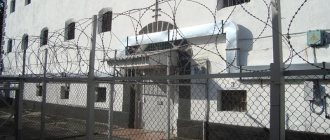Why can you end up in a punishment cell?
Prisons are designed so that a criminal can atone for his crimes within a period set by the court. But not everyone is ready to put up with their situation and for violations they end up in a punishment cell. Some cannot give up familiar items that are prohibited from having in prison. Others constantly start fights and scandals. Still others cannot refuse to play cards. Disrespectful attitude towards security or superiors can also be a reason for punishment. The use and distribution of prohibited substances (alcohol, drugs) is also punishable by imprisonment in a punishment cell.
There are a total of eight prisons in Russia. The remaining correctional institutions are general or strict regime colonies. Particularly dangerous repeat offenders, people who have committed serious crimes and persistent troublemakers who are transferred from colonies are sent to prison.
SCHIZO
Those who violate the regime end up in a punishment cell, which is an isolated cell. In colonies, instead of a punishment cell, convicts can end up in a punishment cell - a punishment cell.
The correctional colony in the Russian Federation is characterized by greater freedom of movement for prisoners and is aimed at correcting prisoners. Convicts are not isolated in cells and can carry out labor activities.
Prisoners are allowed to take a walk outside for 1.5 hours every day. There is no such opportunity in prison.
Persons are placed in a punishment cell at the stage of preliminary or judicial investigation if detention has been chosen in relation to them. There are those for whom the court has already assigned a sentence and they have already entered the zone as a convicted person.
The punishment cell in a colony is a special prison department . Those convicted of violating norms of behavior and the regime of detention are placed there in order to limit their rights and opportunities.
A prisoner in a punishment cell loses the right to have personal belongings (except for personal hygiene items), receive and send letters, and is also prohibited from visits.
What is the difference between a punishment cell and a punishment cell? A punishment cell differs from a punishment cell in its complete lack of communication with the outside world. It is also known that food in a punishment cell is better than in a punishment cell.
The insulator also has the following restrictions:
- The ban applies not only to parcels and letters, but also to the transmission of oral messages.
- People in punishment cells are deprived of the right to order food.
- It is prohibited to register legal marriages.
- If the prisoner is studying at a school or university, he is still prohibited from leaving his cell, but they have the right to ask for textbooks and notes to study the material.
Despite the strictness of their stay in the punishment cell, convicts have the right to walk for 1 hour, the right to hygiene procedures, and also to talk with a clergyman.
What can you get into a punishment cell for:
- scandals, constant fights;
- During a search of the cell, prohibited items were found.
According to Art. 117 of the Criminal Executive Code, the following cannot enter the detention center:
- pregnant women;
- prisoners raising children under 3 years of age;
- disabled people of group 1.
By law, the placement of a prisoner in a punishment cell is limited in time; the prisoner’s stay should not exceed 15 days. For young children, the period in solitary confinement is 7 days.
However, prisoners can stay there longer if the convict is placed for 15 days at the request of the administration.
The prisoner is then sent to his cell, but immediately fictitious charges are brought against him, which contributes to his return to the detention center. Therefore, at the request of the prison management, the convict can remain in the punishment cell for an unlimited time.
The living conditions in such a place are quite cruel. Folding bunks are attached to the wall of the room, but since up to 9 people can be there at the same time, they sleep on them in turns.
The rest are forced to sit on the floor and are in cramped conditions. You can’t count on sleep during the day either, since prison workers continue to ruin the lives of convicts.
Even if there is only one prisoner in the punishment cell, the bunks must be folded during the day, and the prisoner must also spend his day on the floor or on his feet. Inside, the spartan furnishings are combined with dampness and cold temperatures.
Arrangement
The punishment cell in the prison is a small room that does not even have minimal amenities. This directly contradicts Russian legislation. Imprisonment in a punishment cell implies a lack of communication, and not terrible conditions for serving a sentence. The room should have amenities, but finding one in Russian prisons will be problematic. And it’s not a lack of funds to equip the camera.
What does a punishment cell in a prison look like? This is a small room in which the only light source is an electric light bulb under a metal mesh. The protection is made on purpose, because prisoners can use shrapnel to cause injury. As a rule, such a light bulb has minimal dimensions, and its meager lighting is not enough even for such a small room.
The punishment cell may contain an iron bed, which, after sleep, is raised and attached to the wall. Sometimes wooden bunks are a place to rest. The table and chair are also firmly screwed to the floor. Often a cell in a prison does not have a bed or anything to sit on.
A small window in the iron door is used to pass food to the prisoner. While serving his sentence in a punishment cell, he is prohibited from receiving food and parcels. He can only eat what is prepared in the prison canteen. There is also a peephole in the door to observe the convict.
Legal regulation
Currently, there is no clear list of grounds for sending the accused to a punishment cell. The “citizen chief” has the right to assign a person to stay in solitary confinement for almost any sin. It is enough to refer to the fact that the accused violated the regime.
Therefore, legislators decided to define a clear list of grounds for sending to a punishment cell. It is proposed to send prisoners alone only for serious offenses, such as fighting, drinking alcohol, drugs, etc. Minor violations will be included in a special list. If they are committed, the offender will be able to get off with a reprimand.
Moreover, modern rules do not stipulate how a prisoner can make amends to the management of the pre-trial detention center in order to achieve a mitigation of punishment or avoid responsibility altogether.
Why should you be afraid of the punishment cell?
The procedures in all prisons are different, therefore the conditions of prisoners may differ significantly. In one correctional institution they make concessions for those who are in a punishment cell. They are allowed to sit, read books and take half-hour walks in the yard. But in most prisons the punishment cell is located in a damp basement, where in 15 days you can easily get pneumonia and tuberculosis. A weakened body is not able to withstand such harsh conditions. The guilty prisoner must spend most of his time on his feet or squatting. Not everyone wants to sit on a cold concrete floor. The use of personal hygiene products is prohibited. No water procedures, and just a bucket can be used as a latrine.
German punctuality
The borrowing occurred at the time of the heyday of Russian-German relations, when, along with new technologies and customs, sonorous foreign terms also appeared. The German karzer arose from the Latin carcer. Both concepts are a punishment cell, familiar to residents of the 21st century. In earlier times it was interpreted somewhat more broadly:
- dungeon;
- jail.
You will be interested: Boris Panin: biography, exploits, photos
Previously, the definition also pointed to a building or institution, today - only to a specific room with special requirements for the maintenance of prisoners.
Term
How long are they put in a solitary confinement cell in prison? The maximum sentence is 15 days. For non-compliance with rules or illegal actions, you can receive additional hours and days. Thus, prison authorities can increase the term an indefinite number of times. Juvenile offenders cannot stay in a punishment cell for more than 7 days. Disabled people of the first group, pregnant women and convicts who are raising children under the age of 3 are completely exempt from such punishment. You already have an idea of what a punishment cell in a prison looks like and how long prisoners can stay there. It's time to learn more about correctional institutions themselves.
Protection of rights
If a prisoner was treated cruelly in a punishment cell, then he has every right to contact a lawyer. After an impartial investigation, the perpetrators must be punished.
This does not include the mental suffering of the prisoner due to deprivation of liberty, due to the inherent condition of it. Torture is a deliberate act of ill-treatment and punishment.
According to the Declaration against Torture and Cruel Punishment, adopted in 1975, a person who has been subjected to inhumane treatment by prison authorities has the right to lodge a complaint with the competent authorities. The reason for a complaint may be detention in a punishment cell that does not meet the standards.
Such punishment has a negative impact on a person’s condition and degrades his dignity. Confinement in premises that do not comply with established standards is illegal and is regarded as inhumane treatment of people.
In 2022, amendments to the Criminal Code of the Russian Federation are being developed so that it is impossible to put a defendant in a punishment cell for anything.
It is supposed to imprison someone alone only for serious offenses - fighting, swearing, trafficking in alcohol or drugs. It is supposed to introduce mitigating circumstances so that the prisoner takes the path of correction.
The most terrible prisons
Even the most law-abiding citizen has heard about this terrible place. A total of 863 prisoners are currently serving their sentences there. This is strictly monitored by 900 staff members. “Black Dolphin” in Sol-Iletsk is rightfully considered one of the most terrible prisons in Russia. Statistics can serve as proof of this - not a single escape in the entire history of this correctional institution. Terrorists, maniacs, mass murderers and other individuals who can hardly be called human are sitting here. Each of them is under video surveillance around the clock.
How do these prisoners live in prison? The lights in the cells are never turned off, guards walk around with a dog every 15 minutes, walks in the yard with a blindfold and handcuffed wrists behind your back. Sitting on the bed during the day is prohibited: only on a chair that is clearly visible through video surveillance. The cell itself is an iron cage inside a room. Everyone who ended up in the “Black Dolphin” received a life sentence, so they will no longer be able to leave here. Thieves' laws do not apply here, and the only joy for prisoners is work.
Conditions of detention in punishment cells
The conditions in punishment cells are frankly depressing: the area of the cells usually does not reach ten square meters, despite the fact that according to SanPiN it is recommended to allocate 4 meters for one prisoner. The technical plan of the room provides for a small window, but it is often covered with either several sheets of iron or bars.
The insulator is framed by concrete walls, on which soot accumulates and paints them black, a ceiling and a cemented floor. On the sides of the insulator there are folding bunks fastened to the walls. A table or chairs mounted into the floor can be located in the center of the isolator. Water pipes run along the walls.
Bunks are structures in the form of several sheets of wood or iron fastened together. In a punishment cell, the number of sleeping places does not always correspond to the number of prisoners held there, so sleep is subject to a schedule - while some are sleeping, others are crowded into the corners
Each prisoner is given an individual set of linen and a mattress, but this is not always observed, and the quality of the material leaves much to be desired. Attention! The possibility and duration of daytime sleep directly depends on the severity of the duty shift of prison workers, as well as on the peculiarities of the prison schedule - inspection of cells during shifts of duty officers, searches, inspection of the premises by the warden and his deputies, and a medical worker - all this can interrupt rest. Lighting is provided by a storage lamp hanging in the center of the room.
There is a sink in the corner. Facilities are usually represented by either a toilet or a portable bucket located in the corner.
In the cells of punishment cells, convicts continue to perform daily duties, for which they perform alternate duties. Duty includes monitoring the safety of cell equipment, equipment, obtaining dishes and cleaning equipment for prisoners. The duty officer is personally responsible for these items.
His responsibilities also include monitoring the cleanliness of the cell; cleaning the cell bathroom and drinking water tank, and at the end of the prescribed walk - the prison yard. The duty officer in the punishment cell may be assigned other duties by the administration of the correctional institution, if they do not contradict aspects of the legal framework for keeping prisoners in custody.
In addition to being on duty, prisoners for whom a penalty in the form of placement in a punishment cell is imposed with a transfer to work are engaged in labor activities during the day. The right to receive medical care is reserved for prisoners and is carried out in the form of preventive medical examinations and outpatient treatment, carried out in specially equipped rooms located in the buildings of the correctional institution.
The sanitary situation is catastrophic and is due to the inadequacy of the conditions for the number of prisoners, high humidity, and an abundance of cockroaches, bedbugs and fleas. According to the regime, prisoners eat three times a day, and they are also entitled to daily walks lasting an hour and a half (you can find out what prisoners are fed in correctional institutions here).
It is worth noting that for convicts who do not violate the established order while in a punishment cell, the walking time can be increased to three hours a day on the instructions of the head of the correctional institution.
Such restrictions, even in the already difficult conditions of prison, create an unfavorable atmosphere for the mental state of the prisoner and thereby complicate the process of serving the sentence.
During the Soviet period, the punishment cell was characterized by more difficult living conditions. Until 1988, a reduced food standard for prisoners was legally approved. Feeding was carried out every other day. Walking was prohibited, mattresses and bed linen were not provided. Help. Violators of the prison regime were confiscated from their everyday clothes and given a cotton suit with poor hygienic and heat-protective properties. This was the case until 1992, when appropriate changes were made to the legislation regarding the nature of the conditions of stay of prisoners in the punishment cell. We tell you more about the stay of prisoners in punishment cells, pre-trial detention centers and other places for punishment in a separate material.
"White Swan" in Solikamsk
Another prison that houses life-sentenced criminals. The contingent is not much different from the “Black Dolphin”: rapists, murderers, leaders of organized crime groups. But there are some relaxations in the regime. After 10 years, you can switch to more lenient conditions and get the opportunity to write letters. Three people live in cells; they go for walks to the roof of the prison, where special cages are equipped for this purpose. In the first years, criminals are prohibited from studying and working. Exemplary behavior may give you a chance to visit the prison library and even get a correspondence education.
Differences between prison and other correctional institutions
As mentioned earlier, the concept of “prison” does not need to mean all organizations for holding prisoners without exception.
A prison has a number of distinctive characteristics that must be taken into account when deciding on the further detention of a convicted person.
Colonies
Colonies
What is the difference between a prison and a colony? The differences are as follows:
- Possibility of movement. In prison, a person is practically deprived of the right to move; he spends almost all his time in a cell. In a colony, on the contrary, a convict has the right to visit places for walks, work, and meetings. These freedoms are regulated by the statute of the institution and its variety. In particular, in a penal colony, a prisoner has more opportunities than in a general, and even more so, strict regime colony.
- Operating mode.
In the colony, every prisoner is subject to labor service and is required to attend work areas in accordance with the established regime and schedule. Moreover, those convicted receive a salary for their work. Some prisons also have special labor cells, but in most cases they are not used. - Purpose. Colonies are aimed at reforming prisoners, while especially malicious and dangerous criminals are sent to prisons; the main task of such institutions is to isolate a person from society.
The stay of a convicted person in a colony implies a greater number of rights and freedoms, however, everything depends on its type.
Thus, a colony-settlement provides a prisoner with much more opportunities than, for example, a maximum security colony, and, moreover, a prison.
Pre-trial detention center
There are also a number of differences between these types. In particular, people are sent to pre-trial detention centers for whom investigative actions are still underway, or those who are awaiting a court decision or referral to another correctional organization.
In relation to the prison inmate, such a decision is already known, and the guilty verdict has entered into force.
In addition, pre-trial detention centers can house people who have committed crimes of minor gravity, while prison is intended to isolate especially dangerous criminals.
Zones
The difference here is not in the conditions of stay or the contingent of persons subject to imprisonment in this particular institution. The difference is in the very understanding and designation of the term.
So, a prison is a real building designed to isolate and contain criminals.
Zone is a colloquial term used to refer to all correctional facilities for criminals.
In addition, the concept of zone is also used to delimit areas of the same institution, for example, to define residential and industrial areas.
Camps
These concepts differ in many aspects:
- The restrictions on freedom in prison are usually more severe; the prisoner cannot leave his cell without any serious reason.
In the camps such restrictions are more flexible. For example, conditions in a camp can be compared to a barracks. A person lives in a common room, equipped with sleeping, dining and necessary amenities. In addition, he can go for a walk at any time in a courtyard specially equipped for this. - Labor service. In prison, convicts are sent to work extremely rarely; the main task of the camps, on the contrary, is for prisoners to perform labor duties associated with heavy physical labor.
It is a mistake to call all correctional labor institutions a prison, because this organization is not intended for correction, but for the isolation of especially dangerous criminals.
There are a lot of differences between such concepts as prison, pre-trial detention center, colony, camp.
And they relate to conditions of detention, regime and other important aspects.
What is the difference between a prison and a zone? Find out about it in the video:
Didn't find the answer to your question? Find out how to solve exactly your problem - call right now:
| Share with friends: |
Comments:
"Polar Owl" in the Yamalo-Nenets District
One of the most terrible prisons in Russia has such a cute name. “Bitsa maniac” Alexander Pichushkin, major killer Denis Evsyukov and the only surviving terrorist Nurpashi Kulaev (school siege in Beslan) are serving their life sentences here. In this place they practice cruel treatment of “lifers”, since it is very difficult to predict their actions. The prisoners themselves admit that it is better to die than to serve their sentence here. During all this time, not a single escape was made, and on the doors of the cells there are signs on which the articles of the convicted person and a list of his atrocities are written. The special regime here is 13 years. Then some relaxations appear - work, receiving correspondence.
A person who ends up in one of these prisons has no chance of ever being released again. But no one will allow them to take their own lives either - they are being monitored every second. They are forced to live in hell for many years, paying for the atrocities they committed.










